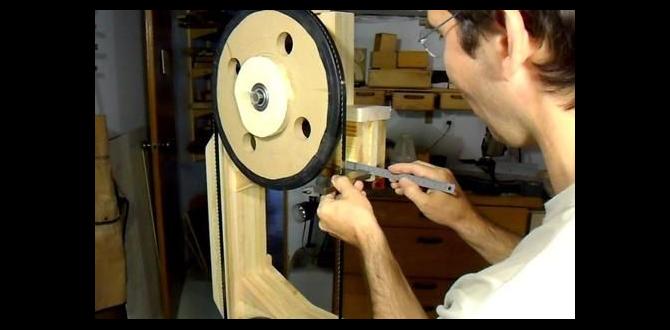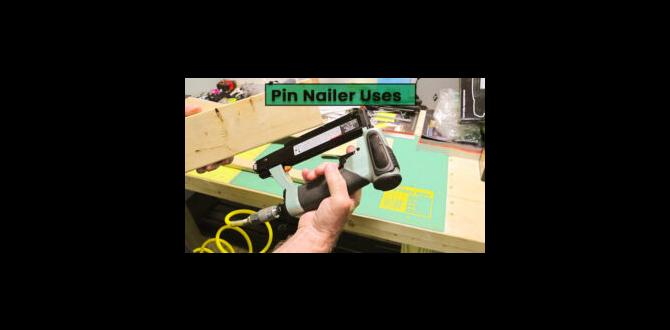Choosing a multi-purpose nailer means getting a versatile tool that can handle many jobs. Look for models that accept different nail sizes and types, offer adjustable depth settings, and are comfortable to hold. Consider the power source (corded, cordless, or pneumatic) based on your projects, and check for reliable brands and good reviews. The right multi-purpose nailer will save you time and effort on various DIY tasks.
Hey there, DIY enthusiasts and budding woodworkers! Jack Shaffer, your guide from Nailerguy, here. Are you staring at a pile of projects and feeling a little overwhelmed by the sheer number of nail guns out there? You’re not alone! It’s easy to get lost in the jargon, but picking the right tool doesn’t have to be a headache. Today, we’re diving into the world of multi-purpose nailers – those fantastic workhorses that can tackle everything from framing to trim. We’ll break down exactly what to look for, so you can confidently choose a nailer that fits your needs and your budget, making your next DIY project a breeze. Get ready to nail it!
Table of Contents
Why a Multi-Purpose Nailer? Your Project’s New Best Friend
Think of a multi-purpose nailer as the Swiss Army knife of fastening tools. Instead of owning a separate nail gun for every single job, a good multi-purpose model can adapt to a surprising range of tasks. This flexibility is a huge advantage, especially if you’re just starting out or have limited storage space. You can use them for everything from building a simple bookshelf to installing crown molding, or even putting up a fence. Having one reliable tool that can adapt to different nail sizes and depths means you’re always ready for the next project, saving you time, money, and the frustration of having the wrong tool.
The convenience of a multi-purpose nailer is that it streamlines your toolkit. Imagine needing to build a deck, then later add some decorative trim to your walls. Without a versatile nailer, you might need a framing nailer for the deck and a finish nailer for the trim. A multi-purpose nailer often bridges this gap, accepting a range of fasteners, which means less equipment to buy, maintain, and haul to your job site. This guide is designed to help you understand the key features and considerations so you can make an informed decision, empowering you to tackle more projects with confidence.
Key Features to Look for in a Multi-Purpose Nailer
When you’re on the hunt for a multi-purpose nailer, there are a few standout features that will make a big difference in performance and usability. These are the bells and whistles that separate a decent tool from a truly excellent one. Let’s break down what’s important so you can make the best choice for your DIY adventures.
Nail Compatibility: The Heart of Versatility
The primary reason to get a multi-purpose nailer is its ability to use different types and sizes of nails. This is where the “multi-purpose” shines! A good model will accept a range of common fasteners, often brad nails, finish nails, and sometimes even smaller brads. This means you can switch between tasks without needing to switch tools.
- Nail Gauge: Nailers are often described by the gauge of the nails they accept. Lower gauge numbers mean thicker nails. For example, a nailer that accepts 16-gauge and 18-gauge nails is very versatile. 16-gauge nails are good for holding pieces together more securely, while 18-gauge (brad nails) are ideal for delicate trim work where you want a less visible hole.
- Nail Length: Check the range of nail lengths the nailer can drive. This is crucial for matching the nail size to the thickness of your materials. A wider range here means more flexibility.
- Nail Type: Beyond size, some nailers can handle different head styles (e.g., brads vs. pins). Understanding what your project requires will guide your choice.
Depth Adjustment: Precision is Key
Being able to control how deep the nail drives into the wood is essential for a clean, professional finish. You don’t want nails sticking out, nor do you want them buried so deep they damage the wood surface or blow through thin materials.
- Tool-Free Adjustment: The best nailers have easy-to-use, tool-free depth adjustment dials or levers. This allows you to quickly fine-tune the depth on the fly as you transition between different wood types or material thicknesses.
- Markings: Clear markings on the adjustment mechanism help you visually confirm your settings.
Power Source Options: Corded, Cordless, or Pneumatic?
The way your nailer is powered significantly impacts its portability, power, and convenience. Each has its pros and cons.
- Pneumatic (Air-Powered): These require an air compressor and a hose.
- Pros: Typically lighter weight, more powerful, and less expensive upfront for the tool itself. They are often considered the workhorses for heavy-duty tasks.
- Cons: Requires a compressor, hose management can be cumbersome, and performance can be affected by airline length and compressor power.
- Cordless (Battery-Powered): These run on rechargeable batteries, offering maximum freedom.
- Pros: Highly portable, no cords or hoses needed, quick to set up. Great for jobs away from power outlets or where maneuverability is key.
- Cons: Can be heavier due to the battery, initial cost is higher, and battery life needs to be managed.
- Corded (Electric): These plug directly into a wall outlet.
- Pros: Unlimited power as long as you have an outlet, generally lighter and less expensive than cordless models. Good for stationary work or repetitive tasks in a workshop.
- Cons: Limited by cord length and proximity to power sources.
For a multi-purpose nailer, cordless models often strike a great balance between versatility and convenience, especially for DIYers tackling various projects around the house. However, if you already own an air compressor, pneumatic might be a cost-effective and powerful option.
Magazine Design and Loading: Ease of Use Matters
The magazine is where the nails are stored. Its design affects how easy it is to load and how many nails you can fire before a reload.
- Capacity: A higher capacity magazine means you’ll spend less time reloading.
- Loading Mechanism: Look for a simple, user-friendly loading system. Some are side-loading, others front-loading. Ease of access is important.
- Jam Release: Most nailers have a quick-release mechanism to clear jammed nails. This feature is a lifesaver when you’re in the middle of a task.
Ergonomics and Weight: Comfort for Longer Jobs
You’ll be holding this tool, often for extended periods. Comfort and balance are crucial to avoid fatigue and maintain accuracy.
- Grip: A well-padded, ergonomic grip can significantly reduce strain.
- Weight Distribution: A well-balanced nailer feels more natural in your hand and is easier to control.
- Trigger Lock: A safety feature that prevents accidental firing.
Safety Features: Protecting Yourself
Nail guns are powerful tools and require caution. Always prioritize safety.
- Contact Trip/Nailer Safety: This is a critical safety feature. The nailer will only fire when the tip is pressed against the material and the trigger is pulled. This prevents accidental firing.
- No-Mar Tip: Some nailers come with a soft tip that prevents marring the surface of delicate materials, like softwoods or veneers.
- Depth Adjustment: As mentioned earlier, good depth control is also a safety feature, preventing over-penetration.
Types of Multi-Purpose Nailers Explained
While the term “multi-purpose nailer” can be broad, it often refers to nailers that can fire both brad and finish nails, or sometimes even smaller pin nails. Here’s a look at the common types you’ll encounter, focusing on their versatility:
1. Brad Nailers (18-Gauge)
These are fantastic for delicate trim, molding, and attaching thinner pieces of wood where a small, discreet nail head is desired. They fire 18-gauge nails, which are quite slender.
- Best for: Attaching baseboards, crown molding, window casings, chair rails, shadow boxes, and light furniture assembly.
- Multi-purpose ability: Many brad nailers can also fire even smaller 23-gauge headless pin nails, adding another layer of versatility for very fine work.
2. Finish Nailers (16-Gauge and 15-Gauge)
Finish nailers use thicker nails (16-gauge or 15-gauge) that offer more holding power. They are great for larger trim pieces like door casings, window frames, and heavier molding, as well as cabinet construction. The nail head is still relatively small, but larger than a brad nail, requiring a little wood filler to conceal.
- Best for: Installing heavier trim, building face frames for cabinets, or any application where you need a bit more grip than a brad nailer offers.
- Multi-purpose ability: Some models are designed to handle both 15-gauge and 16-gauge nails, offering good flexibility for different trim sizes and holding power requirements.
3. Combo Nailers (Brad/Finish Nailer Hybrids)
This is where the term “multi-purpose nailer” most often applies. These are tools specifically designed to fire both brad nails (18-gauge) and finish nails (typically 16-gauge). They are incredibly popular with DIYers and woodworkers because they significantly reduce the need for multiple tools.
- Best for: A wide array of indoor projects, from installing trim, paneling, and wainscoting to building simple furniture and assembling cabinetry.
- Key Advantage: One tool handles the vast majority of trim and light to medium-duty fastening jobs.
4. Pin Nailers (23-Gauge)
These are the smallest and most delicate. They fire headless pins, leaving virtually no visible mark. They are excellent for holding delicate trim components in place while glue dries or for very fine decorative work where no nail head is acceptable.
- Best for: Extremely delicate trim, picture framing, or attaching thin decorative elements.
- Multi-purpose ability: While specialized for pin nails, some combo nailers might also accept pin nails, or you might choose a pin nailer as an addition to a brad/finish combo.
Comparing Power Sources for Multi-Purpose Nailers
Let’s dive a bit deeper into the power sources, as this is a major decision point when choosing your multi-purpose nailer.
| Feature | Pneumatic | Cordless (Battery) | Corded (Electric) |
|---|---|---|---|
| Portability | Limited by hose and compressor | High – completely free of cords/hoses | Limited by cord length |
| Power Output | Generally highest, consistent | Very good, but can vary with battery charge | Good, designed for lighter tasks |
| Weight | Lightest tool itself, but requires compressor | Heaviest due to battery | Moderate |
| Setup Time | Slower (connect hose, compressor) | Very fast | Very fast (plug in) |
| Cost (Initial) | Tool is cheaper, but compressor adds significant cost | Highest for tool and batteries | Lowest |
| Runtime | Unlimited (as long as compressor runs) | Limited by battery life | Unlimited (with power access) |
| Maintenance | Requires oiling (depending on model) and compressor upkeep | Battery charging/replacement | Minimal |
| Best For… | Workshop heavy use, those with existing compressor | Versatile DIY, job sites, maximum freedom | Occasional use, small projects, budget-conscious |
For DIYers, especially those new to nailers, a cordless combination nailer (handling both brad and finish nails) often hits the sweet spot. It offers the freedom to work anywhere without being tethered by hoses or cords, and it can handle a wide variety of common household projects. Yes, the initial investment might be higher, but the convenience and versatility are hard to beat for a beginner to intermediate user.
Essential Tips for Choosing Your Multi-Purpose Nailer
Now that you know what to look for and the different types available, let’s consolidate this into actionable tips to guide your purchase.
-
Assess Your Projects: What Will You Be Doing?
This is the MOST important step. Are you mainly doing delicate trim work? Then an 18-gauge brad nailer (possibly with pin nail capability) might be enough. Need to hang heavier molding or build shelves? You’ll likely want a 16-gauge finish nailer or a combo nailer that handles both 18-gauge and 16-gauge. If you’re building larger structures like decks or fences, a multi-purpose nailer might not be sufficient, and you might need to look into framing nailers (though these are less common in multi-purpose configurations).
Consider the materials you’ll be working with. Softwoods like pine are forgiving, while hardwoods like oak or maple might require more power and potentially thicker nails for sufficient holding power. Always check the nailer’s specifications against the types of wood and fasteners you plan to use.
-
Determine Your Power Source Preference
Do you already own an air compressor? If so, a pneumatic nailer can be a cost-effective and powerful choice. If you value absolute freedom and portability and don’t want to deal with hoses, a cordless battery-powered nailer is likely your best bet, despite the higher initial cost. Electric corded models are generally best for workshop use where power is readily available and portability isn’t a major concern.
-
Read Reviews and Research Brands
Don’t just buy the first nailer you see. Reputable tool brands often offer better quality, reliability, and customer support. Look for reviews from other DIYers and woodworkers. Pay attention to comments about ease of use, jamming issues, durability, and battery life (if applicable). Websites like ToolReviews.com or even manufacturer sites can provide valuable insights. When looking at reviews, consider the reviewer’s experience level; a professional’s needs might differ from a beginner’s.
-
Consider the Ergonomics and Weight
If you’ll be working on large projects or at awkward angles, a lighter, well-balanced nailer with a comfortable grip will make a huge difference. Try to hold the nailer in a store if possible, or at least read reviews that specifically mention comfort and handling. Prolonged use of a heavy or poorly designed tool can lead to fatigue and even injuries.
-
Check for Essential Features: Depth Adjustment and Safety
Prioritize nailers with easy, tool-free depth adjustment. This feature is crucial for getting a clean finish. Also, ensure it has a reliable safety contact trip mechanism to prevent accidental firing. A no-mar tip can be a valuable addition if you’re working with delicate materials.
-
Understand the Nail Loading Mechanism
Loading nails should be straightforward. Ideally, the magazine should be easy to open and close, and able to hold a decent number of nails so you aren’t constantly stopping to reload. A quick jam release is also essential for troubleshooting on the go.
-
Budget Wisely: Balance Cost and Quality
Multi-purpose nailers range in price. While it’s tempting to go for the cheapest option, remember that you often get what you pay for. Investing a bit more in a quality tool from a reputable brand can save you frustration and money in the long run with better performance and durability. Look for sales or consider refurbished tools from trusted sources. For many DIYers, a good 18-gauge brad nailer and a 16-gauge finish nailer in one cordless combo unit offers the best bang for your buck in terms of versatility and performance.
Using Your Multi-Purpose Nailer Safely
Nail guns are powerful tools, and safety should always be your top priority. Following these



